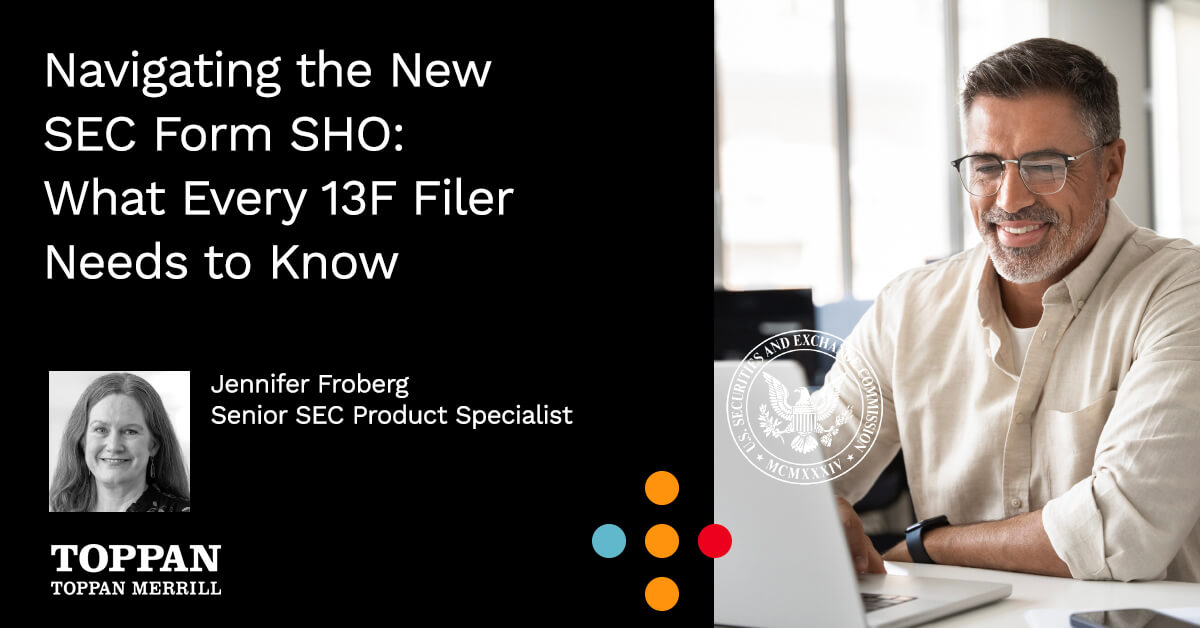Transcript
Scott Snyder: Hello, I’m Scott Snyder, and I’m very pleased to be joined today by Guy Stanzione, Director of SEC Compliance Services at Toppan Merrill.
Guy, thank you very much for being here today.
Guy Stanzione: Thanks, Scott. Thanks for having me.
Scott: Today, we’re focused more on the outcome for shareholders for funds to be completely TSR ready, including print and distribution requirements at the share class level, electronic delivery, and website compliance. Let’s start with the complexity of TSR production from a print and distribution perspective at the share class level. What are funds going to face as they try to be TSR ready?
Guy: Although the need to manage investments is currently handled at the share class level, the increased number of reports that are going to be generated due to the TSR requirements of recreating a TSR to share class level is going to definitely compound the complexity of accurate document delivery and meeting all the elements of distribution. On a very high level, one of the elements that are being introduced that a lot of people aren’t thinking about are the changes to householding. So, if you look at householding in the simplest form, you may have two people with the same last name at the same address invested in the same fund, the way householding currently works, one person will get the book, the other person would not. It’s a significant savings in cost and postage.
But in the world of TSR where documents are created at the share class level, same example, two people, same household, same last name, same address, same fund, I may be invested in a different share class than my wife, which means the rules of householding will change and we both would need to get a report in the mail.
Scott: Guy, one of the significant components of the TSR requirement is that the SEC has taken a print first posture here. A little bit of a departure from what we’ve seen in previous years and other rulemaking where it’s really been electronic distribution. Can you talk about why the SEC perhaps made that decision?
Guy: Sure. In the release, the SEC referenced many times the Mutual Fund Summary Prospectus rule that’s been around since 2009. Modeling the Summary Prospectus rule, which is also a print first model, the SEC considered this a good fit for that same print delivery model, which would not have a significant impact on overall costs.
I think the challenge here, though, is Summary Prospectus currently is at the fund level. Whereas TSRs are at the share class level, so it’s more pieces in the mail, which is adding to the scope and the complexity of the overall manufacturing process.
Scott: So Guy, complexity, right, is what I’m hearing from you specifically related to the print component and the distribution side of TSRs. So funds really need to be sure and certain and really validate that their vendors can handle those requirements. There are a couple of key questions that or answers that funds should be sure to have before they make that final vendor selection.
Guy: I would use a couple of terms to answer that question, customizable and a term we’ve used a lot over the last couple of sessions, platform. So, what I mean by customizable. You’re now manufacturing documents at the share class level there’s many more going into the distribution stream. You have to be able to have the quality checks in place to make sure the right product is going to the right person.
At the same time, you want to have a direct to print model where those documents are coming out of the source, going right into the print and distribution stream. So, customization is important. Platform, you know, we don’t talk a lot about platform when you talk about print. But with the introduction of the share class level distribution, you could have some share classes that run into hundreds of thousands of copies, where others, maybe a couple of thousand. So, we talked about having a direct to print workflow, but at the same time, the flexibility of a platform that can support long as well as short run print and distribution.
Scott: So, Guy, while print and distribution obviously have their own complexities based on the TSR requirement, this doesn’t mean that electronic delivery is going away and delivering those TSRs, really at the preference level of the individual investor. Can you talk a little bit about eDelivery or electronic delivery and maybe how that is impacted.
Guy: Sure, Scott. One thing I wanted to say before I go into actually eDelivery is one of the elements of 30e-3 that confuses some people about whether it still exists or not was the opt in to paper process with the rescission of Rule 30e-3, the opt in privilege has also been rescinded. So, you can no longer opt into paper. You fall back into a paper first delivery model, unless you have previously consented to electronic delivery and that is a consent model where you choose the documents you want to receive electronically. And we used the term platform before and now we’re going to use it again. The platform you would want is a platform that is document agnostic, that allows some documents to be delivered in paper, while others can still be delivered electronically. Adding the complexity of the share class level presentation, much like physical print, you have to make sure that you’re sending the notification of document availability to the right person for the right share class. And there are many, many forms, one of which being a PDF attachment in an email, which we all realize is not the preferred model. A platform that supports eDelivery presentation at the investor level, where an investor can find all of their documents, in a customized microsite, which allows them to view their documents at any time is the preferred model.
Scott: So Guy, electronic doesn’t just mean delivery though, right? Electronic in 2024 means website. And the SEC has mandated that the TSRs be available on websites. And not only that, but they meet the SEC’s Layer Disclosure Framework. Talk about the challenge of getting the TSR to that point to meet the SEC requirement.
Guy: This takes a lot of the conversation that we’ve already had and pulls it into one more additional topic. We talked about the data, we talked about the content, we talked about the single source of truth to generate your EDGAR filing. But also that same single source of truth is the content that needs to be posted to a website. Much like the SEC did with the Mutual Fund Summary Prospectus Rule. Where they introduced the concept of a summary document being distributed to an investor and the more detailed disclosure being presented on a website. They’re doing the same thing with the TSR, where the TSR becomes that summary document and the more detailed disclosure, the Items 7 to 11 that we previously spoke about being taken from the N-CSR and put on a website.
It seems like a simple model, but now you have to look at what are the full components of the N-CSR. What is required to be on the website versus what’s extraneous and probably does not create the best user experience. And really what you want is a platform that will allow you to extract the necessary content from a larger piece of content to be able to post it to the website while meet the 60-day web hosting requirement the SEC has introduced.
So, looking back, you have a summary document with the availability of more detailed disclosure, which is being reintroduced in the layered disclosure framework for TSRs. And the SEC has openly said in the final release that they are modeling this after the Summary Prospectus rule for continuity purposes.
Scott: Guy, thanks for that insight and obviously your expertise as we’ve talked through the nine different challenges and really today, talking about that post SEC filing requirement and really getting this information into the hands of the people who need it, which are the individual investors. Obviously, lots of challenges for funds to consider as they become TSR ready in 2024. We appreciate you outlining all of that for our audience.
Overview
On The Dot (Episode 4) – A conversation with Guy Stanzione about the SEC Tailored Shareholder Reports mandate and tackling the print and distribution challenges at the share class level.


